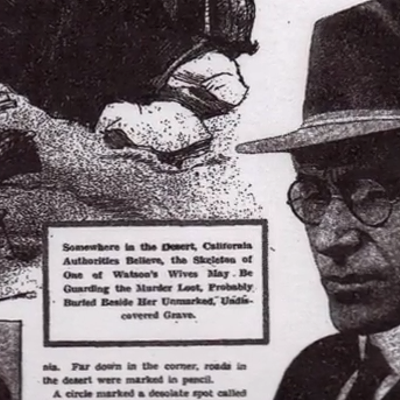It's Friday noon and retired physician Bob Dickson parks his SUV along the side of the road where Bernard and High Drive meet on Spokane's South Hill. This is where Dickson starts his frequent forays down the steep hill into what is officially known as the city of Spokane's High Drive Park. Others call this area "The Bluffs."
From the top, Dickson looks out and sees forested hillsides, the lush, green Creek at Qualchan Golf Course on the floor of the Latah Valley, Highway 195 winding south toward the Palouse and hundreds of homes on the hills across the highway. It's a stunning view, but after a minute of drinking it all in, Dickson wants to start down the path he has hiked for more than 40 years. "This is a civic treasure," he says as he points with his walking stick to an extensive network of trails that crisscross the hill and lead down to Latah (or Hangman, if you prefer) Creek.
"When I first moved here in 1963, there was nothing [no trails] here," Dickson says. He points to one trail he says he put in himself, "just with a shovel and a rake. It's not hard to make one."
Now his one pathway has been supplemented by a complex network of pathways, many created in the last few years by bicyclists, "the real trail blazers," Dickson calls them. He refers to a two-trail system on the hill, steeper paths for walkers, gradual trails for mountain bikers. The two groups co-exist on this hill and they take care of it. The trails are amazingly free of litter. "The people who use these really appreciate what they have," he says. Like others who enjoy the Bluffs, Dickson has adopted an attitude of stewardship toward the trails. Sometimes he comes down with a set of shears and lops off branches that hang low over trails. "By pruning these trees up, you can really open some vistas and enhance the experience as you hike down here," says Dickson.
At this time of year, the Bluffs, from Polly Judd Park on 14th Avenue all the way around to Hatch Road on the south end of Moran Prairie, are well-used by the neighbors and by people who drive in from other areas. Much of the land is owned by the city and designated as parkland or open space, putting it off limits to development. Some, though, is privately owned. One steep parcel, just over the top of the hill from 57th and Hatch, was recently approved by the city hearing examiner for a condo development (although that decision has been appealed). Another parcel on 17th that was proposed for a housing development a few years ago may soon have a different function.
Like the Dishman Hills or Riverside State Park, the Bluffs hide a deeply evocative past. Because of their narrow shape, steep vertical expanse, and the uncertain status of their periphery, the Bluffs serve as a laboratory for whatever interactions between civilization and wilderness happen to be going on inside the Spokane city limits. Their future seems to be evolving by the moment.
LATAH TIME
More than 10 million years ago, when a warm, wet climate caressed western North America, lush deciduous forest blanketed the Spokane country. The flora along Latah Creek at that time combined the richness of present-day Asian forests with those of southern Appalachia. Vegetation included ancient gingko trees; sequoia, cypress, and incense cedar; chestnut and elm; laurel and magnolia; sweetgum and locust; redbud and hydrangea; fig, cherry, blueberry and persimmon; four kinds of maples, six willows and nine different oaks.
During this same period, vents opened up over a tectonic hot spot south of the Snake River, spewing molten rock that oozed toward Spokane. The lava flows slowed down at the hills around Cheney, Marshall and Medical Lake, but continued north far enough to gradually obstruct the drainage outlet of Latah Creek. Silt sifted down through the fresh water to settle on granite and schistose rocks. Falling leaves were trapped in this silt, squeezed dry by the layers of sediment on top of them, and fossilized. Over time, hundreds of feet of clay and shale accumulated, all of it riddled with evidence of the ancient greenery.
Geologist J.T. Pardee called the silt layers "Latah Clay," and the Miocene Epoch that created them "Latah Time." In the 1920s, Pardee described how the molten flows from the south piled up until rim rock lava intruded into these Latah sediments, deforming some, cutting into others, burying most of the clay under layers of basalt. The bedded clay and invading lava flows of Latah Time set the stage for the much more recent Ice Age Floods that shaped the landscape we see today.
At the tail end of the Pleistocene Epoch, around 20,000 to 15,000 years ago, warming weather eroded an ice dam at the mouth of the Clark Fork River on Lake Pend Oreille and sent the contents of Glacial Lake Missoula rushing south and west. The great wall of water that swept down the Spokane River backed up Latah Creek from its mouth, just below our present downtown. The powerful flood waters stripped away basalt and re-exposed layers of Latah Clay. At its height, the deluge also crashed over the top of the Glenrose-Moran Prairies and poured into Latah Creek upstream.
The meeting of opposite flows created eddies and side pools that allowed tons of debris to settle out of the maelstrom. Undulating layers of silt, sand, gravel, rocks and clay pockets remain plainly visible today in the exposed cuts of the Latah Creek Bluffs, and geologists still study them to interpret the story of the deluge. In fact, the exposed layers below High Drive provided the first convincing evidence used by several scientists (including Dale Stradling and Eugene Kiver of EWU) to make the case that not one but numerous Ice Age floods from Lake Missoula combed across the region.
People who walk the lower bluffs above Latah Creek today are treading the end result of the last of those Pleistocene floods, between 13,000 and 14,000 years ago. In the millennia since, many blocks of Latah Clay have tumbled out of the sheer walls and rolled down to the creek, splitting open on their bedded layers to reveal leaf fossils from the Miocene forest. As soon as the leaf impressions are exposed to open air, dry winds begin to blow them to dust.
The floods gushing out of Lake Missoula also inundated whatever living things lay in their path. There is no way to know how much life the floods destroyed, but in recent years scientists like George Last of Pacific Northwest Laboratories in Richland have begun to realize that the remains of some Ice Age mammals drifted into quiet backwaters and were preserved in settling mud. More than 40 Eastern Washington mammoth recovery sites fit this description, including the bones of several mammoths found in 1876 on an upper Latah Creek homestead. Some of those Latah bones were eventually restored into a single mammoth mount and remain on display at Chicago's Field Museum of Natural History.
HANGMAN TIME
At some undetermined point after ages of leafy hardwood forests and fiery basalt flows, of elephants and outsized floods, people came on the scene. In time, Latah Creek connected homelands and resources of the Coeur d'Alene and Spokane tribes. Coeur d'Alene tribal historian Felix Aripa describes the valuable runs of trout, whitefish and salmon that would ascend the creek from the Spokane River. "The whitefish was more abundant and was easier to dry and kept longer than the salmon," says Aripa. "But the salmon was very important." These fish all wriggled their redds and laid their eggs among gravels laid down by the Ice Age floods, sorted by flow strength to the perfect size and shape for the individual species.
Other tribes associated with the Spokane and Coeur d'Alene peoples also used Latah Creek as a route between the Clearwater Range and the Spokane country, utilizing the fish, roots, upland game birds and animals that thrived in the valley. Elders from different local bands would gather to discuss setting fires to clear underbrush so berry bushes could flourish and game could run. When fur agent David Thompson walked along the Spokane River in 1811, his vision of the place was muted by smoke from local blazes that may have been started by Spokane people to manage the land.
There are several versions of the origin for the name of this creek. In their book about the history of the Spokane Tribe, Robert Ruby and John A. Brown say that "Latah" stems from a Nez Perce word for "pine and pestle." Although that fits with this early history, Colonel George Wright's actions during the bitter tribal conflicts of 1858 forever altered the identity of the drainage. After Wright ordered Qualchan and six Palouse men to be hung not far upstream from the Bluffs, all locals, regardless of race, called the creek by one name. Only five years after the incident, U.S. Army surveyor Captain John Mullan published a traveler's guide to his famous road from Fort Benton to Fort Walla Walla, and on it he clearly marked the stream as "Hangman Creek." Periodic attempts to change the name back to Latah have failed, in part because, as Spokane tribal archaeologist Randy Abrahamson says, "we always want to remember what happened there."
MODERN TIMES
Time stood still for a few years after the turmoil of 1858, but by the early 1870s, the flow of white settlers had resumed. One of the first businessmen to arrive at the new village of Spokane Falls was Oregon resident James N. Glover, who made the journey from Portland to Lewiston via steamboat in early spring 1873, then rode overland through the Palouse Hills till he found the creek.
"Hangman Creek was bank full when we reached it," Glover later wrote, "and we set about to find a place to cross. I saw an Indian, lying face down on the ground, warming himself in the sun, as I thought. I found that he was digging sunflower roots..." When Glover reached the Spokane Valley he said it was "filled with sunflowers, and looked like a field of gold. I was charmed by the entire country."
What charmed James Glover still holds sway today when early every spring great swaths of arrowleaf balsamroot carpet the Bluffs with big downy leaves and bright yellow sunflowers. In the time of yellow blooms, they come after the buttercups and yellow bells, and are followed in turn by several kinds of desert parsleys or biscuitroot, which supplied food for the local tribes in the form of roots, shoots and seeds. Blue flowers with familiar common names such as bluebells, larkspur, wild hyacinth and lupine spring up after the balsamroot, mirrored in wetter places by occasional blue camas. As long as the cool weather lingers, a continuous run of showy wildflowers decorates the open slopes, with each new turn of the trail holding some surprise: fields of foamy northern buckwheat; dense clumps of yellow Oregon sunshine; confusing varieties of penstemons and locoweed. Fusing them all together are luxurious stands of bluebunch wheatgrass, the gold standard of grazing fodder for early horsemen whether they were tribal or white.
During hot summer weather, many walkers quit using the dusty, treacherous trails because feet slip, and mouths go fuzzy during the long climb out. But more scattered wildflowers continue to bloom in this oven, and some of the most exotic, such as mauve mariposa lilies and greenish-white rein orchids, wait for the dry weather to appear. It's high summer before true Indian hemp, an important source of cordage for all the surrounding tribes, shows its bright red stems, before blazing star unfolds its white petals at dawn and dusk.
But the Bluffs do not belong to native wildflowers alone. By the late 19th century, many familiar weeds had arrived in Spokane as seeds hidden in imported hay or as garden transplants from homesick emigrants. Large-scale disturbances, such as the railroad filling up a huge gully below 14th Avenue with rubble of all descriptions, helped to spread the exotics. These days, dry summer weather alters the look of the Bluffs because that's when weeds begin to dominate the native vegetation. Cheatgrass, quickly ripening to seed, shows its distinctive pink-purple color. Blue cornflowers, a world traveler with several different common names, line the High Drive running trails. Every Bluffs traveler seems to view one particular weed species with special disdain, and several of the least favorites look to be increasing every year.
Fire traditionally encourages the growth of several weed species; natural or human-set, summer flames continue to shape the Bluffs' landscape. Three years ago, several fingers from a spot fire that started down on the creek ran straight up the bunchgrass slopes to High Drive below 29th Avenue, threatening its line of comfortable homes. Fire crews unrolled hoses and sawed charred ponderosa pines out of the way in a few hours, but the Bluffs' recovery will take much longer to sort out. In some places, the bunchgrass has responded to the jolt of heat, and northern buckwheat, one of our most beautiful herbs, blooms in profusion across what were blackened streaks. On other slopes, where perhaps the flames ran a little hotter, cheatgrass and rush skeletonweed seem to be the winners.
The Bluffs will certainly feel such heat again. If you drive along Highway 195 from Vinegar Flats toward the bottom of Hatch Road, you can watch the variation from open slopes with well-spaced pines change to overgrown dog-hair stands. It's not difficult to guess what conditions might make the difference between a brush-thinning ground fire and a conflagration.
As in tribal times, such blazes affect wildlife distribution, but these days flames are far from the only factor. Anyone who steps off the edge of the Bluffs notices a dramatic change in bird noise, from hoarse house sparrow gasps and wolfish starling whistles to the manic chatter of pygmy nuthatches and sharp, metallic red crossbill kips. You might be startled by a sharp-shinned hawk chasing pine siskins, or hear a chipping sparrow unwind its dry trill, over and over, from a low pine branch. Over the past 10 years, a dramatic increase in human and dog activity has thinned out some birds that used to be dependable singers, especially ground nesters such as ruffed grouse. Several springs ago, some walkers watched a red-breasted merganser, long-necked and awkward, investigate a potential nesting hole in a ponderosa pine snag only a couple of hundred yards below High Drive. Since a self-appointed trail maintenance crewman chainsawed several of the best such snags available, there are a lot fewer cavities for nesting, and no mergansers in sight.
Mammals present a similar story line -- some critters slink away from the increased human use of the Bluffs -- while others learn how to deal with it. Deer do not like dogs, but each year a wayward moose manages to negotiate its way upslope to spend a few days crashing through people's back yards. Cougar have been known to use the Bluffs as a staging area for small pet-hunting expeditions. Skunks and raccoons thrive on both paved streets and mountain bike trails, and porcupines still chew bark in dripping rings from young pines down low. The coyotes that denned for several years running on the flats opposite the Creek at Qualchan Golf Course seem to have retreated for now, and it's unclear exactly where they could find an expanse of woods protected enough to whelp a litter of pups. River otters, heavily trapped during the fur trade era, apparently have been able to adjust to the human presence and have occasionally been seen surfing down Latah Creek past Qualchan Golf Course during hard spring runoffs. They remain an ephemeral presence, however, and it's hard to figure out how much space, in the water and on the land, they need.
PRESERVING THE BLUFFS
In May 1912, the city of Spokane bought an unnamed plot of land below 29th Avenue for $45,000. In its story covering the transaction, the Spokesman-Review noted that the tract adjoined parcels owned by the Boulevard Company "said to contain between 60 and 80 acres, extending down the Hangman creek slope," and that Boulevard had already indicated they were going to donate their piece to the city for parkland.
Back then, the Bluffs had also caught the attention of John Charles Olmsted and Frederick Law Olmsted, the landscape architects from Brookline, Mass., who advised the city's Board of Park Commissioners in 1913 that "Latah Park" should be set aside as one of the city's four signature parks. "It includes the wooded bluffs and a sufficient area of nearly level land above the bluffs for baseball and other field sports. Much of the plateau portion is wooded and suitable for rambling grounds and picnicking," the Olmsteds wrote. "The bluff drive will command beautiful and extensive views from south to northwest across the valley of Latah Creek and over an extensive reach of picturesque country beyond. In the larger ravine a drive would descend to the valley of Latah Creek... The total area of this park as planned is 2,286 acres, of which 657 acres are on practically level land above the bluff, 557 acres are on very steep and almost valueless land, and the rest slopes moderately steeply and irreguary [sic] down to the creek."
Of course, "Latah Park" never came to pass, but some of the Olmsteds' vision was implemented. "It was part of the City Beautiful movement," says Taylor Bressler, the city parks department's manager of planning and development. "The city, fortunately, bought a lot of land then and aggressively preserved that area."
It created High Drive, which provides marvelous views at the western and southern edges of the Bluffs; turnouts allow people to stop and peer down several hundred feet into the valley. Hatch Road, a two-lane twisting drive, was built to allow drivers to descend the southern side of the prairie into the valley. Other publicly owned sections of the Bluffs have been bought and either left in their natural state or turned into parks (Hangman, Latah Valley and High Drive, among them). In its most recent Comprehensive Plan, the city has designated most of those areas as open space, making it difficult, if not impossible, to legally develop them.
BUILDING ON THE BLUFFS
One day last month in the Spokane City Council chambers, an attorney and engineers for developer Yong Lewis made their case for building a 100-unit, 30-building condo project on the steep slopes near 57th and Hatch. Their audience was city Hearing Examiner Greg Smith and a few dozen people who live in the adjacent Quail Ridge housing development.
Engineer Karl Harmon from GeoEngineers talked about the geologic makeup of the site, the likelihood of erosion there, concluding that, "The project site is suitable for development. The primary geologic hazards can be mitigated with careful design and development."
Randy Hahn from Hahn Engineering explained the work that would be done to stabilize the slopes and summarized changes that were made to to the project to allay the concerns of city planners and engineers. Ann Winkler from Sunburst Engineering said work would be done to minimize the effects from the increased traffic to the area.
Stan Schwartz, an attorney for Quail Ridge homeowners, countered, saying the soils on the steep Tuscan Ridge site are highly susceptible to erosion and that development there would bring significant risk. He argued the developer's mitigation work wouldn't be enough.
In a written decision issued two weeks ago, Smith determined the city's land use code and Comprehensive Plan allow Tuscan Ridge to be built, although he warned "the site will not be easy to develop because of the topography, soils and slope." He continued, "The proposal will not have a significant adverse impact on the environment or the surrounding properties and necessary conditions can be placed on the proposal to avoid significant effects and interference with the use of neighboring property or the surrounding areas." Those conditions regulate the development's stormwater, sewer and water service, and Smith mandated "an erosion/sediment control plan, detailing how dust and runoff will be handled during and after construction of each phase."
Quail Ridge homeowners have filed an appeal, which will send Lewis's application for the Tuscan Ridge planned unit development to the City Council, which will make the final decision.
City planner Steve Haynes says Tuscan Ridge is one of only a few developments that have been proposed for the Bluffs in the last 10 to 15 years. Two other housing projects, Blackwood and Casa Bella, sit lower on the hill where Tuscan Ridge is proposed.
A few years ago, a development named Ashland Estates, proposed for 17th and Ash, ran into opposition from neighbors and from Avista, which has power lines in the area. The project was stalled and now has taken a different turn: it has qualified for money from Spokane County's Conservation Futures fund. Negotiations are underway for the city to buy the two Ashland Estates parcels and keep them in public hands.
REGULATING THE BLUFFS
When Bob Dickson walks south along the Bluffs toward Hatch Road or north toward downtown, he jokes that he's never sure on whose land he's treading. Most of it is owned by the city, but there are no signs that tell him whether he's trespassing or not. That laissez-faire approach bothers those who wish the city would be more hands-on in regulating the Bluffs.
Taylor Bressler from the parks department says more active management of the Bluffs may come in the future, especially if traffic there continues to increase. But for now, he says, the city is working with two bicycle advocacy groups to maintain trails and keep pathways that are heavily used from sloughing off down the hill.
"We pick up litter and keep the weeds down at the top," says Bressler. "We're constantly patrolling the area to keep it from becoming a dump site."
He says the city is also working with volunteers who have global positioning units (GPS) to create a map of the Bluffs.
"Maybe once we get that done, we can create an official trail system that we can try to keep people to stay on," says Bressler. "Eventually I see us putting up signs that say 'No Motorized Vehicles' or that state that this is park land. But for now, we're trying to build a sense of ownership among the people who use the parks, to make friends with our neighbors."
Bob Dickson says he welcomes anything the city does to improve the Bluffs. "I know if the city had the resources that they'd be down here," he says. And that's why he quietly does his part to make the experience for hikers and bicyclists more enjoyable. "I want to make sure these trails are popular enough that the city would never dare to close them."
KINGS OF THE HILL
Tubbs Hill is the gem it is today partly because of luck but mostly because the people of Coeur d'Alene are downright feisty about public access and deeply involved in local politics. And the story behind protecting Tubbs Hill offers a lesson as other areas -- like the Bluffs in Spokane -- become prized by developers and everday citizens.
In the late 1960s a plan was announced to create a resort and convention center atop Tubbs Hill. It was rejected by the city planning commission but later approved whole-heartedly by a City Council citing economic development.
"Then the voters threw out the entire council with that as the issue," says Scott Reed, a Coeur d'Alene attorney with a long history of advocating on behalf of regular folks.
Local politics in the Lake City can swiftly turn into entertaining bare-knuckle brawls -- even in the era before blogs -- and while it's difficult to tell exactly what's what from a distance of 40 years, it appears Tubbs Hill was a real catfight.
Consider: After the debacle with the city council getting the heave-ho, Idaho Water Company, which owned much of Tubbs Hill, announced that another suitor -- a German firm -- was planning to build condos on the hill and then for good measure jacked up city water rates to double what they had been.
The newly elected City Council and Mayor Ron Edinger mounted an immediate counteroffensive to raise enough money to buy Idaho Water Company. The city, including federal matching funds and private fund-raising by the Jaycees and others, raised $391,100 under various tight deadlines to purchase two separate 34-acre parcels that placed the bulk of Tubbs Hill squarely in public hands.
"The idea was to get the water company, and along with that came the land," says Edinger, who is currently a city councilman. "We put it up to a bond election and -- I won't say overwhelmingly -- the people passed it something like 1,300 in favor and 700 or 800 opposed.
"The city since that time has tried to keep it in a natural state -- that's the object of Tubbs Hill, to keep it in a natural state," Edinger says.
In addition to a populace willing to fight for public access on the lake, sheer good luck has also played a role, Reed says.
He points to 1936, when downtown Coeur d'Alene was railroad tracks and sawmills. The city purchased a mill that had gone bust and intended to erect an oil-burning power plant on the site of what is now McEuen Field at the northern base of Tubbs Hill.
"Fortunately that fell on its face," says Reed, who is close to completing a book about the history of Tubbs Hill.
Tubbs Hill is seen as something of a miracle, an island out of time accessible only on foot. The hill is 130 acres with vest-pocket beaches and hiking trails that offer a glimpse of what the lakeshore looked like before resorts and bars and big box stores and chambers of commerce got involved.
The hill, though it has a feistier history, may provide a model for the Bluffs here in Spokane. Tubbs Hill is now a Coeur d'Alene city park, though one that is intentionally kept largely undeveloped. A volunteer group, the Tubbs Hill Foundation, continues to raise money to augment the city budget and turns out for twice-yearly cleanups, tree-plantings and constant monitoring, says Mark Weadick, president of the nonprofit foundation.
"There's never been any discussion about selling any portion of it to anybody. It's a landmark and we want to keep it as a landmark," Edinger says.
"It was a remarkable effort," Reed says.
— KEVIN TAYLOR






















